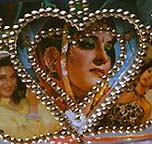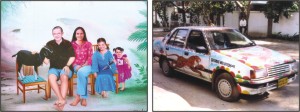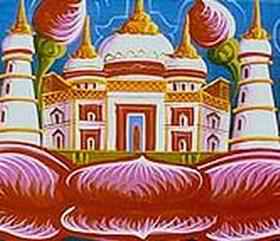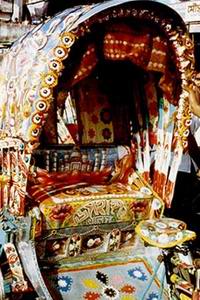 Starting off from humble beginnings, rikshaw artist S.A. Malek is a fairly popular figure in Dhaka, especially among the expat community. This typically Bangladeshi talent can be traced back a couple of generations; Malek's paternal grandfather and father were commercial artists, originally based in Calcutta. His father moved to Dhaka before independence and Malek was born in 1969 in Madhob Pasha village in Narayanganj district. Funnily enough, he continues to live there, village life being more appealing than the bright lights of Dhaka.
Starting off from humble beginnings, rikshaw artist S.A. Malek is a fairly popular figure in Dhaka, especially among the expat community. This typically Bangladeshi talent can be traced back a couple of generations; Malek's paternal grandfather and father were commercial artists, originally based in Calcutta. His father moved to Dhaka before independence and Malek was born in 1969 in Madhob Pasha village in Narayanganj district. Funnily enough, he continues to live there, village life being more appealing than the bright lights of Dhaka.
School did not appeal to the young Malek, so he became his father's apprentice in his early teens. As far as Malek can recall, it all began about thirty years ago when his father's shop in Narinda, old Dhaka, attracted the attention of some members of the diplomatic community, and he was established as a rikshaw artist. This reputation was not automatically transferred to his son; it has not been an easy ride for Malek. “There are no exceptions to the types of art I'll put my hand to; I'm willing to try all forms of painting,” he is proud of his versatility. He initially painted billboards, banners and screens. Rikshaw boards and backrests soon followed; these were sold in old Dhaka's Bongshal market. He also specialised in baby taxi bodywork at his shop Jamuna Auto Centre in Mogh Bazaar.
 For five long years, he concentrated on and mastered different forms of rikshaw art. Malek was “discovered” by an Icelandic diplomat roughly ten years ago. “I did a lot of work for him” he said, referring to a photo of a car covered in rikshaw art. This was his entry into Dhaka's expat world, introduced through the Icelander's friends' circle. It was only a matter of time before demand for Malek's artwork was on the up, and all this by word of mouth. Nearly a quarter of a century later, he's never looked back. Malek's days of baby taxi painting are behind him now.
For five long years, he concentrated on and mastered different forms of rikshaw art. Malek was “discovered” by an Icelandic diplomat roughly ten years ago. “I did a lot of work for him” he said, referring to a photo of a car covered in rikshaw art. This was his entry into Dhaka's expat world, introduced through the Icelander's friends' circle. It was only a matter of time before demand for Malek's artwork was on the up, and all this by word of mouth. Nearly a quarter of a century later, he's never looked back. Malek's days of baby taxi painting are behind him now.
 For the commissioned rikshaw paintings, the starting point is a photograph. His preferred medium is enamel (“There's more glamour in enamel than there is in oil”). The painting is usually done on tin, which is first given a white background. Malek then sketches directly on the tin and fills in the background. The paint tends to dry quite quickly, he revealed. The likeness to the original photo is quite amazing. The composition of the painting depends on his client, though most tend to leave it up to him. There could be a myriad backgrounds and subjects, but Malek's favourite motifs are rural scenes, monkeys, tigers, colourful birds, mango trees, boats, and of course, rikshaws! His subjects could be seated on a rikshaw, dressed in Bangladeshi wedding finery, jogging alongside tigers or taking a boat ride on the Balu River. The use of typical Bangladeshi themes is very apparent, making the paintings vibrant and eye-catching. Apart from rikshaw paintings, Malek also does rikshaw boards, backrests, tin trunks and toy chests. The paintings and trunks are of varying sizes and take a couple of weeks to complete, while four to five rikshaw boards get done in a day.
For the commissioned rikshaw paintings, the starting point is a photograph. His preferred medium is enamel (“There's more glamour in enamel than there is in oil”). The painting is usually done on tin, which is first given a white background. Malek then sketches directly on the tin and fills in the background. The paint tends to dry quite quickly, he revealed. The likeness to the original photo is quite amazing. The composition of the painting depends on his client, though most tend to leave it up to him. There could be a myriad backgrounds and subjects, but Malek's favourite motifs are rural scenes, monkeys, tigers, colourful birds, mango trees, boats, and of course, rikshaws! His subjects could be seated on a rikshaw, dressed in Bangladeshi wedding finery, jogging alongside tigers or taking a boat ride on the Balu River. The use of typical Bangladeshi themes is very apparent, making the paintings vibrant and eye-catching. Apart from rikshaw paintings, Malek also does rikshaw boards, backrests, tin trunks and toy chests. The paintings and trunks are of varying sizes and take a couple of weeks to complete, while four to five rikshaw boards get done in a day.
His love for village life is the impetus for Malek's travelling around the countryside. Often, this results in oil on canvas paintings of pastoral scenes, painted from memory; “I use my heart as a camera”, he declared. While his rikshaw paintings are popular mostly with expats, his oils are primarily preferred by Bangladeshi clients. He has dabbled with watercolours and even done figurative painting in and on buildings in Dhaka, Gazipur and Narayanganj. He has also had to resort to calendar work in leaner times.
 Malek has had moderate success through exhibitions. In October 1999, the Alliance Francaise held an exhibition of several rikshaw artists, including Malek's father and many of his apprentices, in an attempt to promote rikshaw art as a form of folk art. More recently in 2000, Malek was invited to participate in the Dhaka German Embassy's 50th anniversary celebrations, which included a group show featuring different artists. Given the German nature of the theme, Malek came up with caricatures of two classic German brands Lufthansa and Mercedes Benz! His paintings were subsequently incorporated into a calendar commissioned by the German Embassy.
Malek has had moderate success through exhibitions. In October 1999, the Alliance Francaise held an exhibition of several rikshaw artists, including Malek's father and many of his apprentices, in an attempt to promote rikshaw art as a form of folk art. More recently in 2000, Malek was invited to participate in the Dhaka German Embassy's 50th anniversary celebrations, which included a group show featuring different artists. Given the German nature of the theme, Malek came up with caricatures of two classic German brands Lufthansa and Mercedes Benz! His paintings were subsequently incorporated into a calendar commissioned by the German Embassy.
It is with an almost resigned air that Malek says that those involved in rikshaw art aren't seriously considered as “artistes”. His greatest wish would be to create an awareness of his art form within his own country to begin with, and then to be able to promote it elsewhere. Does life imitate art, or is it the other way around? Certainly, Malek's paintings are a good imitation of life in the rikshaw lane(Nivedita Raitz von Frentz, Daily Star, September 21, 2007).
Starting off from humble beginnings, rikshaw artist S.A. Malek is a fairly popular figure in Dhaka, especially among the expat community. This typically Bangladeshi talent can be traced back a couple of generations; Malek's paternal grandfather and father were commercial artists, originally based in Calcutta. His father moved to Dhaka before independence and Malek was born in 1969 in Madhob Pasha village in Narayanganj district. Funnily enough, he continues to live there, village life being more appealing than the bright lights of Dhaka.
For five long years, he concentrated on and mastered different forms of rikshaw art. Malek was “discovered” by an Icelandic diplomat roughly ten years ago. “I did a lot of work for him” he said, referring to a photo of a car covered in rikshaw art. This was his entry into Dhaka's expat world, introduced through the Icelander's friends' circle. It was only a matter of time before demand for Malek's artwork was on the up, and all this by word of mouth. Nearly a quarter of a century later, he's never looked back. Malek's days of baby taxi painting are behind him now.
For the commissioned rikshaw paintings, the starting point is a photograph. His preferred medium is enamel (“There's more glamour in enamel than there is in oil”). The painting is usually done on tin, which is first given a white background. Malek then sketches directly on the tin and fills in the background. The paint tends to dry quite quickly, he revealed. The likeness to the original photo is quite amazing. The composition of the painting depends on his client, though most tend to leave it up to him. There could be a myriad backgrounds and subjects, but Malek's favourite motifs are rural scenes, monkeys, tigers, colourful birds, mango trees, boats, and of course, rikshaws! His subjects could be seated on a rikshaw, dressed in Bangladeshi wedding finery, jogging alongside tigers or taking a boat ride on the Balu River. The use of typical Bangladeshi themes is very apparent, making the paintings vibrant and eye-catching. Apart from rikshaw paintings, Malek also does rikshaw boards, backrests, tin trunks and toy chests. The paintings and trunks are of varying sizes and take a couple of weeks to complete, while four to five rikshaw boards get done in a day.
Malek has had moderate success through exhibitions. In October 1999, the Alliance Francaise held an exhibition of several rikshaw artists, including Malek's father and many of his apprentices, in an attempt to promote rikshaw art as a form of folk art. More recently in 2000, Malek was invited to participate in the Dhaka German Embassy's 50th anniversary celebrations, which included a group show featuring different artists. Given the German nature of the theme, Malek came up with caricatures of two classic German brands Lufthansa and Mercedes Benz! His paintings were subsequently incorporated into a calendar commissioned by the German Embassy.